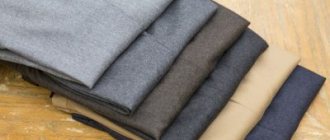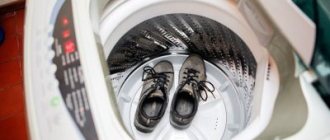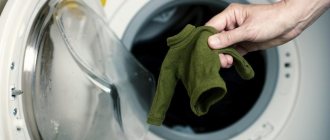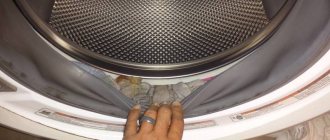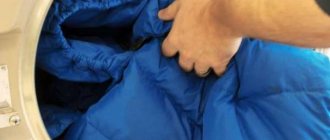The best materials for sewing socks – what is recommended to choose?
When purchasing socks, it is recommended to carefully study the information provided by the manufacturers on the label. Not all products are suitable for daily use; some are difficult to care for.
Cotton underwear is in first place - it is hygienic, easy to wash, durable and inexpensive. Among the disadvantages is that durability depends on density. It is recommended to wear at different times of the year - the fabric retains moisture and heat well.
Wool socks confidently hold second place in terms of practicality and durability. It is better to wear it in cooler times - in summer your feet will be too hot.
Wool socks
Bamboo or eucalyptus products are in third place. Like bamboo, eucalyptus has excellent hygroscopic qualities and does not cause difficulties in getting rid of stains. Among the disadvantages is fragility; even careful care is not enough to avoid damage with regular wear.
ARTICLE FOR YOU
How to wash Pavloposad scarves: wool and silk in a washing machine and by hand
Nylon and polyester socks are among the cheapest and most impractical. Poor water absorption and restriction of air access to the skin are part of the disadvantages. The advantages are that they keep their shape, are easy to wash, and are wear-resistant.
Basic washing rules
The main requirement that must be met before soaking is to study the information on the label. Typically, the recommended temperature, use of detergents, and care features after removing contaminants are indicated here.
A prerequisite is sorting. It is better to send colored and white ones into the washing machine separately - there is a risk of causing multi-colored stains to appear on light-colored laundry. After sorting, turn it inside out and shake out any debris, dust, or sand.
Rules for washing socks
If using a washing machine is not recommended, carry out the process manually. The use of aggressive detergents for delicate materials is prohibited - there is a risk of damage to the fibers. The linen will quickly lose its shape, the threads will become thin and quickly break.
Preparing dirty items for washing
Before you start washing, your socks need to be properly prepared. Basic recommendations:
Sort socks by color. White, black and colored items are washed separately.- Remove all visible dirt from socks. This could be threads, hair and other dirt.
- Turn the socks inside out. Sometimes it happens that small objects, pebbles and other debris get inside the product.
- Walk over the surface of the product with a machine to remove pellets.
Removing dirt manually
Before washing socks by hand, it is recommended to soak them. The water temperature is no higher than 30 degrees.
Add detergent (gel, powder). Place products in soapy liquid after complete dissolution of the drug. The duration of soaking is from 4 hours; for persistent stains, it is recommended to extend the process to half a day. During this time, change the water 1-2 times.
Manual removal of dirt is carried out in stages:
- Soap the fabric with laundry soap (if there are greasy stains, use detergent).
- Rub vigorously with your hands, rinse if necessary, and re-soap.
- Change the water, rinse in clean cold (about 20 degrees) liquid.
- Wring out and hang to dry.
Wash by hand
If the label indicates that spinning is not recommended, allow the water to drain and hang to dry. The duration of washing depends on the degree of soiling, the amount of laundry, and the type of material (delicate fabrics require careful handling, which takes longer).
Features of washing different socks
The appearance and wear resistance of the socks depends on the washing method. If you wash it incorrectly, pills will appear, the material will stretch or, on the contrary, shrink. Like any other clothing, socks need to be pre-sorted by color and type of fabric.
Depending on the color
The easiest way to wash black and dark socks. They can be thrown into the drum together and combined with dark clothes, such as jeans and T-shirts. To prevent dirt from transferring to other things, it is recommended to turn your socks inside out and shake them before washing.
It is better to wash colored items by hand, one pair at a time. However, if the fabric does not fade, it is acceptable to combine it with other colored clothing. You can check your socks for shedding using a damp cotton pad. It must be pressed to the colored area and held for several seconds. If the paint has transferred from the fabric to the cotton pad, it is better to wash such items separately.
White socks are the worst to wash. To remove dirt better, it is recommended to pre-soak it in soapy water. You can add a stain remover. Black, yellow, gray stains are rubbed with bleaching soap (laundry soap will do). After this, you need to keep the socks in a dry basin and then wash them in the usual way.
Useful and effective ways to restore whiteness to socks.
Depending on the type of material
Any material can be washed by machine or by hand. However, washing parameters depend on the type of fabric. How to wash socks made from different materials:
- Cotton ones can withstand automatic washing up to 60°C. Can be pre-soaked.
- Synthetic ones should not be washed in hot water, this will lead to shrinkage. When washing by hand, do not stretch. Machine washable only on delicate cycle.
- Woolen ones are washed in a basin using washing liquids. Wool should not be rubbed, twisted or wrung out.
Openwork and nylon socks can only be washed by hand in cool water. You can wash it with soap under the tap.
Do I need to soak socks before washing?
Regardless of the color and characteristics of the material, it is better to wash your socks immediately to remove dirt. If dirty steam sits in a laundry basket for weeks, the stains will become firmly absorbed into the fibers. Soaking in a basin for two hours will make washing easier. If your heels are not too dirty, you can do without soaking.
Soaking with baking soda or oxygen bleaching will return the whiteness. It is enough to dilute in water and leave the products for 30–60 minutes. It is not recommended to use chlorine-containing products even on cotton; socks are made of thin fabric, so chlorine and other aggressive substances will most likely deform the item.
Cool water up to 40°C is suitable for soaking. Boiling water will strengthen the dirt in the fibers. Blood and sweat stains come off easily in cold water.
Getting rid of dirt using a washing machine
Using a washing machine is an effective way to deal with any dirt. If the laundry is not too dirty, you can do without pre-soaking. If there are stains on your socks that are difficult to remove, put them in the machine and turn on the “Pre-wash” mode.
Washing by machine also requires compliance with certain rules. The first is to study the information provided by the manufacturers. Usually the recommended temperature and the material from which the underwear is made are indicated. Most machines have the function of processing according to the fabric, which allows you to abandon experiments that are destructive for things.
Cotton, synthetic, nylon products can be washed at 60 degrees. For more delicate materials, choose a gentle mode - up to 40 degrees.
If dirt is removed from the socks of a person suffering from skin diseases or fungal diseases of the nail plates, increase the temperature to 60 degrees. It’s even better to pre-boil the laundry, and only then put it in the washing machine.
The duration of washing depends on the model of the washing machine. Usually the active mode, rinsing, spinning takes up to one and a half hours. If stains are removed from delicate fabrics, it is recommended to select the delicate mode.
In the drum of a washing machine, items easily become entangled, even tied into a tight ball, which is quite difficult to untangle. A special bag that can be filled with soiled laundry will help you avoid trouble.
Washing socks in a machine
Some useful tips
- To simplify the selection of pairs, you need to purchase a batch of socks that are the same in material and color. Having bought three dozen identical pairs of products, you can make a laundry bag once a month exclusively from socks, without mixing them with other things.
- In the case when the pair is not very dirty and needs to be washed to refresh, it is recommended to put one sock inside the other so that they do not get lost.
- It is convenient to use a separate box or bag for dirty socks, and connect the items in pairs with special clips.
- Some people don’t like it when socks go into the wash at the same time as other things, and it takes a long time to wait for just such items to be completely washed. In such cases, socks are often washed by hand.
- The easiest way is to lather each sock with soap and place them in this form in a basin. After this, we put the socks on our palms, like mittens, and begin to wash them. The process is reminiscent of vigorous hand washing. In this way, you can wash even heavily soiled steam in a few minutes.
- Inventive people have come up with another way to help wash small items without using a washing machine. You need to take a five to six liter plastic container, pour a soap solution into it, push it through the hole, close the lid tightly, and place the bottle in the trunk of the vehicle. During the day of driving, all the things in the bottle will be washed perfectly, all you have to do is rinse them.
Which laundry detergents should you prefer?
The use of aggressive detergents to remove soiled socks is not recommended. If the material is too delicate, there is a risk of significantly reducing wear resistance. The exception is underwear made of durable fabrics that are not susceptible to deformation or the aggressive effects of drugs.
For gentle washing, it is recommended to use gels. Most products contain enzymes that effectively remove stubborn stains. Take into account one of the qualities of active elements - enzymes at high temperatures lose some of their properties.
Be sure to first study the information on the bottle - recommended mode, temperature, tissue requirements. If the product is not suitable, do not experiment - such actions will affect the cleanliness and integrity of the fabric.
ARTICLE FOR YOU
How to properly wash anti-stress pillows and toys: in a washing machine and by hand
Washing powder is another product that effectively removes most dirt. If you choose the right temperature mode and program in the washing machine, you can wash the products without any special difficulties.
Detergents
Processing features depending on color: white, dark, colored
Dirt is more noticeable on white socks than on dark ones. Therefore, you have to wash them more often.
To remove blackness and prevent yellowing of the fabric, you can periodically use bleaching compounds. These can be chlorine-containing products, but you need to take into account that they lead to tissue damage.
The fibers lose strength and holes will appear on the product faster. Therefore, preference should be given to delicate bleaches containing enzymes and active oxygen.
Examples of such means are:
- Vanish Oxi Action Gold (the cost of 0.45 ml gel is about 145 rubles),
- Boss Maximum (for 0.45 powder you will have to pay about 50 rubles).
Colored socks are washed separately from other items, as they tend to fade and stain light-colored fabrics.
To care for them, stain removers that do not contain a bleaching component are used . The optimal washing temperature is 40 degrees.
Whitening – what to use, rules, requirements
For washing white items, it is recommended to use boric acid. For 4 liters of water – 12 g. substances. It is allowed to replace a rather aggressive element with citric acid or juice squeezed from citrus slices. The duration of soaking socks is up to two hours. Soak items that are too dirty 2-3 times.
The use of preparations with bleaching properties is another way to obtain snow-white products. Vanish is popular among housewives; for stains that are too stubborn, it is recommended to use Antipyatnin.
The dosage is indicated on the label; exceeding the amount of the drug or combining several products is prohibited - such actions will not affect the quality of washing.
Some housewives use “Whiteness” to whiten clothes. You should not overuse the drug - the active components quickly corrode the fibers, which will affect the durability of the socks. “Whiteness” is used against stains that are not amenable to more gentle means.
For cotton materials, it is recommended to use chlorine-containing preparations. Step-by-step application of funds:
- Fill the container with 2 liters of warm water.
- Add a chlorine-containing preparation (50 g).
- Stir until the powder is completely dissolved.
- Add detergent (can be replaced with gel), you will need up to 100 g.
- Soak the products, rub a little with your hands, and leave overnight.
Whitening socks with folk remedies
In the morning, wash your socks as usual. There is no need for a washing machine - a concentrated chlorine-based product will cope with stains, contaminated soles, and a yellow tint.
About white socks
Alas, no matter how carefully you take care of them, after a short period of wear and a couple of washing cycles, white socks lose their pristine freshness - they begin to turn gray, turn yellow, and become covered with pellets. These tips will help you keep them clean for as long as possible:
- Make it a habit to wash your crisp white socks after every wear. It is easier to remove fresh dirt from products of this color than old dirt.
- When machine washing, add a little dishwashing detergent to the drum, which will help keep the hosiery from losing its whiteness.
- Ammonia and ammonia are substances that will not only help quickly whiten socks, but also soften tap water. Dosage – 2-3 spoons/liter of water.
This is what clothespins for washing socks look like
- Another way to return whiteness when machine washing is to pour an additional glass of baking soda into the powder compartment.
- When soaking, sprinkle a little lemon juice into the water and leave the socks in it for about three hours. And it is even permissible to rub it into severe stains.
- If your socks are stained with paint from the inner material of your shoes, soak them in a solution of boric acid (20 g/l of water). Then all that remains is to rinse them thoroughly and dry them.
- Add 9% table vinegar (based on 1 teaspoon per liter of water) when soaking.
Another type of clothespins
- White cotton socks can be saved by good old boiling. Let us remind you of this procedure (additionally, watch the video in this article): take an unnecessary old saucepan, dilute an aqueous solution in it with the addition of laundry soap and soda ash powder. Once cooked, immerse the socks in the container and place it on the fire. Stirring occasionally, bring the contents to a boil. It should remain in this state for 10 minutes. Then take the pan to cool, and then rinse the socks in clean water.
Use a bag like this to avoid losing small items when washing.
Tricks for getting rid of pellets
Woolen products, in addition to numerous advantages, have disadvantages, one of them is the appearance of pills. It is recommended to wash wool on both sides, so defects appear on the outside, inside the products.
For preventive purposes, it is recommended to use laundry conditioners. The use of special preparations will extend the life of the yarn, prevent the threads from abrading and the appearance of pellets. The recommended washing mode is delicate. Do not choose a water temperature of more than 40 degrees.
Angora products are also often covered with numerous pellets. It is easy to avoid the appearance of defects - use warm liquid, avoid strong spinning, and use gentle washing preparations. Friction of angora fabric is also not welcome, so it is better to avoid hand washing.
When should you boil?
White items are boiled with the addition of detergent when they have stubborn stains or have turned yellow. Colored and black socks are boiled to disinfect them. This procedure is also carried out to remove persistent sweat odor.
Algorithm of actions:
- pour water into an aluminum or enamel bowl;
- add washing powder and soda;
- place socks in the solution, boil them for 10-15 minutes;
- drain the water, rinse the steam.
During boiling, the products will float, so they need to be heated from time to time.
Tricks for making products shrink
It often happens that products stretch and become deformed. There are a few tricks to help your socks return to their previous shape. The easiest way is to use hot water (20-30 degrees higher than specified by the manufacturer), but only if the sock material can withstand heat treatment. If possible, boil followed by rinsing and spinning.
Another method actively used by housewives:
- After washing, soak the items in hot water (up to 70 degrees).
- After a quarter of an hour, gently squeeze.
- Place socks in ice-cold liquid.
- Leave for half an hour.
- Wring out and dry on a clean terry cloth.
A hot battery will perfectly remove deformation and stretching. The method is usually used for woolen products. Soak the socks in hot water, wring them out lightly, and hang them on hot radiators. Wait until completely dry.
How to dry quickly at home?
You need to dry your socks naturally. If washing was carried out with a spin cycle, the products will dry completely in 3-4 hours. You can speed up this process by using an iron by ironing the pair from the wrong side several times. The steam function must be turned off.
Do not place socks on the radiator. This can lead to unsightly streaks and stains.
Special drying conditions are required only for woolen products. They are washed without spinning, after which they are laid out on a wire rack in a horizontal position. If you hang them, they may lose their shape.
How to wash so that items do not shrink and retain their shape
One of the basic rules that should be remembered when washing socks is to prevent the product from shrinking, use only comfortable water. Hot or cold liquid is dangerous to fabric, regardless of the type.
It is recommended to use washing powder, gel, and conditioner. A special substance will prevent stretching of the fabric, the appearance of pilling, and will preserve the shade of the fabric.
If the socks are made of angora, use regular shampoo for washing. Be sure to make sure that there are no bleaching agents in the composition, especially if you are washing black socks.
ARTICLE FOR YOU
How, why and how to wash clothes, things and shoes from second-hand stores
When using a washing machine, turn off the spin mode. It is better to easily squeeze out any remaining moisture after washing, spread the items in an even layer on a towel, and leave to dry completely.
Drying socks
For nail fungus
Nail fungus is a contagious disease . Microscopic particles of mycelium settle on all surfaces, including items of clothing.
To prevent the infection from spreading and leading to repeated self-infection, you need to wash your socks correctly.
Basic moments:
- When washing by hand, you need to use gloves;
- Items should be machine washed at maximum temperatures;
- It is recommended to boil socks every 3-4 washes;
- You can only load things into the washing machine that belong to a sick person.
To destroy fungal spores after washing, it is recommended to iron socks.
Read more about washing socks if you have fungus here.
Is it possible to wash socks and panties at the same time?
A question that often worries novice housewives is whether it is allowed to put socks and underwear into the washing machine drum at the same time? You should not do this - panties are personal hygiene items and must be washed separately.
It is better to wash even laundry sent in bags separately - temperature conditions, detergents, and spin cycles are significantly different. Briefs require delicate handling, while socks are more “resistant” to temperature fluctuations, powder (gel) composition, and spins.
Important Tips
To wash your socks and not render them unusable, you must follow the following recommendations:
- Socks are turned inside out before washing. This will allow you to maintain their attractive appearance for a long time.
- When washing socks with other items at the same time, you need to take into account the recommendations that apply to all products.
- When loading a large number of pairs, you need to use a special mesh.
White socks should be washed after each wear. This will prevent dirt from penetrating deep into the fabric. Bleach can be used periodically.
How to dry socks correctly?
As with washing, the information on the label will come in handy when drying items. Here, caring manufacturers provide requirements that will avoid situations that are dangerous for socks. If the item of clothing is made of durable, wear-resistant fabrics, it is allowed to spin it using a washing machine.
Drying as usual - in the fresh air or near a radiator (hanging socks directly on a hot radiator is not recommended if there is no goal of reducing the size).
If the manufacturer has warned that you should not wring out socks or dry them at high temperatures, use a clean terry towel. Lay out the products, remove folds, straighten, smooth with your hand, and leave until completely dry.
Is ironing process required for socks?
Do items need to be ironed? It all depends on the fabric from which the socks are made. If the material is delicate, expensive, and does not tolerate elevated temperatures, it is better to abandon the process. It is recommended to use an iron for durable fabrics that cannot be deformed even when exposed to high temperatures.
The use of steam is mandatory - this will shorten the process and, if necessary, eliminate minor defects (tighten clothes that have stretched out during wear or washing).
Is it necessary to iron socks?
For ironing, use two cotton napkins - place the socks between a light cloth and carry out the process. If the items have slightly shrunk, it is recommended to wet the napkins, wring them out lightly, then stretch the linen and iron it with a hot iron. If necessary, repeat the steps, each time stretching the fabric to the desired size.
If you are washing the underwear of a person infected with a fungal disease, you should iron the socks, regardless of the fabric. The main rule is to iron from the back and front sides. The iron temperature is hot, the use of steam is encouraged.


